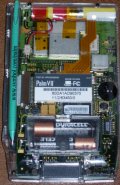
Logged in as Guest Sun, Oct. 21st, 7:27 AM.

|
|
|
||
Of course, that started me thinking about the VII in general. Here's the history as I know it: Back in May of 1999, when palmOne was still part of 3Com, the Palm VII was released in New York City to much fanfare. The VII was basically a Palm III with a Mobitex modem integrated into it. (I'm sure there were other differences, but to end users that's what it was.) The Mobitex modem connected to a proprietary wireless network known as Palm.Net, and cost $9.99 per month to subscribers. The kicker for the VII was that it introduced what is now know as "Web Clipping". The idea behind Web Clipping was that websites would create custom components known as PQAs (Palm Query Apps) that would be downloaded and installed onto users' devices. The concept was that the PQA would provide a frontend for websites and that only transient/changing data would have to be transmitted over the network to the VII. The Mobitex network that the VIIs used is/was originally designed for pagers and really isn't suitable for large amounts of data. At the time, Web Clipping seemed like a pretty good idea. Epilogue As you have probably deduced, the VII (and its successor the i705) didn't catch fire, and eventually the Palm.Net network was deactivated and now is no longer in existence. As they say, hindsight is always 20/20, so I won't spend time dwelling on the failure. What I would like to mention is that the VII (and the i705) introduced a whole secondary network library generally referred to as INetLib. This interface was only ever intended for the Palm.Net network, and therefore is completely obsolete. Unfortunately, the INetLib.h header is still included in the SDKs, so many developers that are new to the Palm networking interfaces stumble upon them and try to use them. It is understandable why they try; among the INetLib functions are high level (HTTP) transmision functionality. For example, there is an INetLib function called INetLibURLOpen. The help file on INetLibURLOpen doesn't mention that it has been obsoleted and in fact describes the purpose of the function as "Accesses a URL on the Internet or in the cache." That is a pretty cool sounding function, and if you search the rest of the SDK, you won't find an equivalent function in the standard NetLib interfaces. I'm not sure why PalmSource hasn't created a high level interface for sending/receiving HTTP requests. It seems like it would be a pretty useful library. In fact, I could see a whole library of functionality that could send/receive on a number of higher level protocols. Imagine a library that could setup and handle a telnet session, or an SSH session. What about a simple FTP or SFTP transfer? What about an SMTP or a POP3 session? My wish list could go on and on. I would envision that the library could take care of the lower level details of establishing a network connection and abstract away the implementation details of the higher level protocols, thereby making Palm developer's lives much easier. Ah well. It's all just a wish right now. Maybe someday we'll see it. Until then, we all can just keep reinventing the wheel. =) -Jon |
||
| Submitted by bosshogg on Wednesday the 31st 1970f December 1969, at 04:00 | ||
